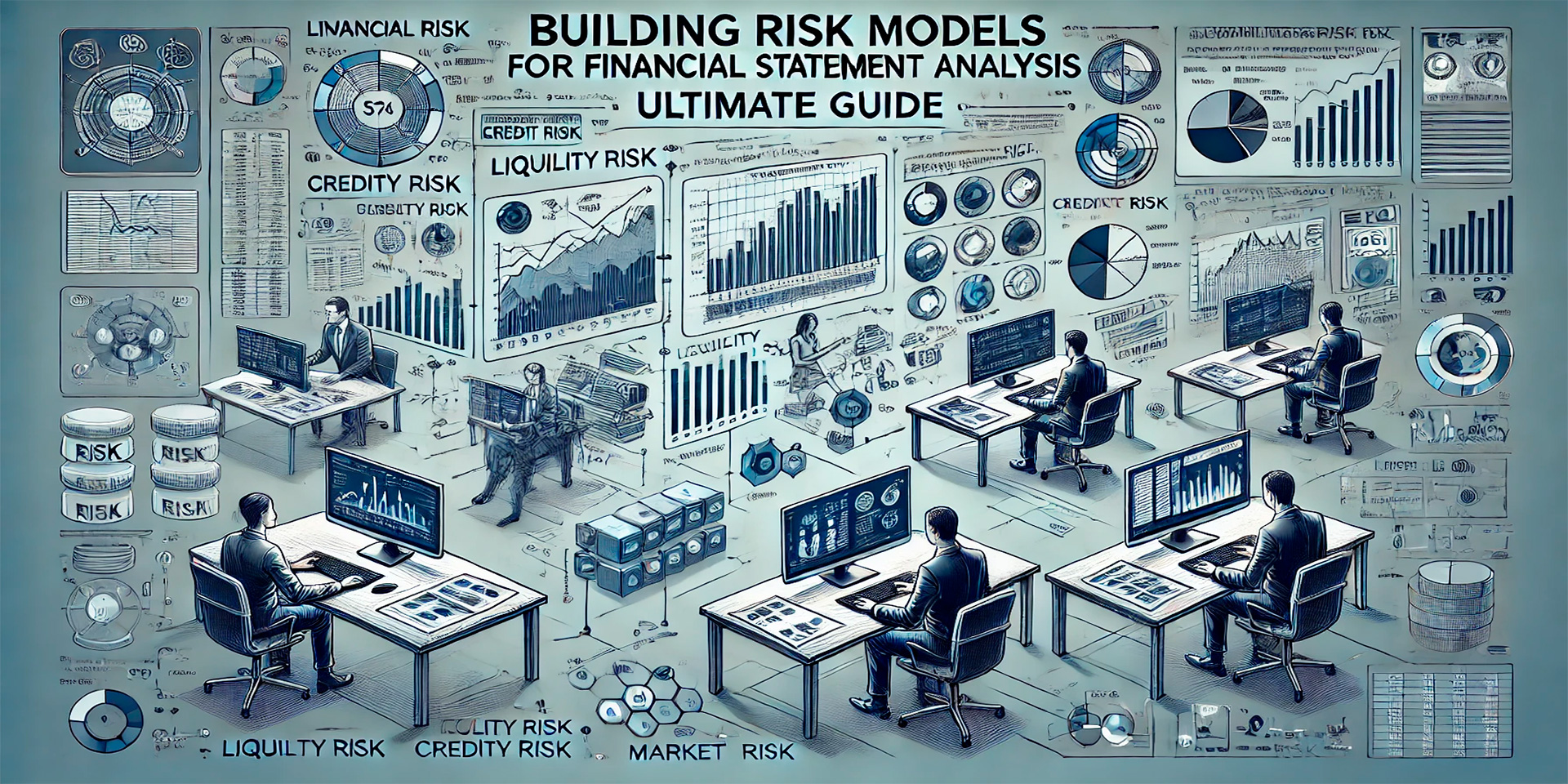Building risk models for financial statement analysis is crucial. By identifying and evaluating potential risks such as market fluctuations and credit defaults, you can gain insights into uncertainties impacting a company’s financial health. These models give investors the tools to make informed decisions, mitigating potential losses and bolstering financial stability.
To identify and select key risk factors, start by defining clear objectives and gathering comprehensive data. Test different scenarios and regularly update your model to maintain accuracy. Focus on variables like credit scores, debt ratios, and market volatility. This structured approach ensures comprehensive risk coverage and relevance in a shifting business landscape.
Constructing an effective financial risk model involves identifying all potential risks using tools like SWOT analysis. Engage data scientists to clean and prepare data, and involve financial experts for a balance of quantitative and qualitative insights. Machine learning enhances these models by uncovering hidden patterns and enabling real-time decision-making, making your risk assessments more accurate and adaptable to changing conditions. This holistic method ensures robust risk management strategies and better-informed business decisions.
What Is The Importance Of Building Risk Models For Financial Statement Analysis?
Building risk models for financial statement analysis is crucial because it helps you identify and evaluate potential risks that could impact a company’s financial health. These models provide insights into uncertainties like market fluctuations, credit defaults, and operational mishaps, enabling you to make more informed and strategic decisions.
By using risk models, you can quantify and manage various risks, such as market risk, credit risk, and liquidity risk. This ensures that your investments and financial decisions are well-informed and data-driven. You develop effective risk management strategies, mitigating potential losses and enhancing financial stability.
In closing, by building risk models for financial statement analysis, you gain a clearer understanding of potential financial risks and can create proactive strategies to safeguard your investments.
How Do You Identify And Select Important Risk Factors In Financial Modeling?
To identify and select important risk factors in financial modeling, you should follow a structured approach:
First, define your objectives. Understand what you want from your model, whether it’s project feasibility, predicting financial outcomes, or assessing specific risks like market or credit risk.
Gather relevant historical and current data. Make sure the data is reliable and covers the necessary scope, including economic indicators, company performance metrics, asset returns, and macroeconomic factors.
Analyze the data using quantitative methods. Look for patterns and correlations with statistical analysis and consider qualitative assessments to capture external factors that numbers might miss.

Identify variables significantly impacting your financial outcomes. Common risk factors include credit scores, debt ratios, market volatility, liquidity, operational risks, and macroeconomic conditions.
Use scenario analysis and stress testing. Test your model under various scenarios to understand how different risk factors influence outcomes, identifying the most critical risks and their impacts.
Update your model regularly with new data. Reassess risk factors to keep your model relevant and accurate.
Overall, by defining clear objectives, gathering and analyzing data, selecting key variables, testing scenarios, and keeping your model up-to-date, you can effectively identify and select important risk factors in financial modeling.
What Are The Key Steps Involved In Constructing Effective Financial Risk Models?
To construct effective financial risk models, you need to follow these key steps:
First, identify all potential risks relevant to your financial model, such as market, credit, operational, and liquidity risks. Use tools like SWOT analysis, risk registers, or PESTEL analysis to ensure you don’t miss anything.
Next, gather and prepare data by working closely with data scientists to collect, clean, and transform relevant information. Accurate and comprehensive data is crucial for reliable inputs.
Engage a diverse team, including bankers, data scientists, quants, and industry experts. Their combined quantitative and qualitative insights will enhance the model’s robustness.
In the model design phase, develop a statistical model that balances complexity with practicality. It should be detailed enough to capture critical risk dynamics without being overly complicated.
Apply statistical methods like variance, Value at Risk (VaR), and stochastic modeling to quantify the risks. Utilize scenario simulations and stress tests to ensure the model’s reliability under various conditions.
Validate and test the model through back-testing and real-world validations. Adjustments may be necessary to improve prediction reliability.
Regularly update the model to reflect current market dynamics and changes in risk factors. This ensures the model remains relevant and accurate over time.
Finally, use the model for decision-making to make informed and strategic decisions regarding investments, credit, and risk mitigation.
As a final point, by following these steps, you can create a financial risk model that effectively identifies, quantifies, and manages financial risks, enabling you to make better strategic decisions.
How Do Credit Risk Analysis Models Determine The Probability Of Default?
Credit risk analysis models determine the probability of default (PD) by examining factors that influence a borrower’s ability to meet debt obligations. When you look at PD, you see the chance that a borrower will fail to make required payments within a specific timeframe, often expressed as a percentage or decimal value.
You’ll find models using statistical techniques like regression analysis, incorporating both market variables and financial characteristics such as cash flow, revenue trends, operating margins, leverage, and liquidity. Financial institutions use these models to assess loan exposure, set risk limits, pricing, and other loan terms. Credit rating agencies employ similar models to assign credit ratings.
Machine learning and advanced statistical methods help improve accuracy by using large datasets, including historical credit bureau data. For example, credit scores, debt-to-income ratios, and borrower behavior patterns play crucial roles. You might notice these models consider external financial data and apply sensitivity analysis to account for varying scenarios.
FIs also utilize structural models, like Merton models, which assume complete knowledge of a company’s assets and liabilities, and reduced-form models that use observable variables without assuming full financial knowledge of the company. Credit scores and ratings from agencies like S&P, Fitch, and Moody’s imply a certain PD based on historical defaults and financial health indicators.
To sum up, credit risk analysis models combine financial data and advanced statistical methods to determine the probability of default, helping lenders make informed lending decisions and set interest rates to mitigate risk. By incorporating real-time data, these models become more accurate, enabling you to better assess and manage credit risk.
What Role Does Historical Data Play In Financial Risk Modeling?
Historical data plays a pivotal role in financial risk modeling by providing a detailed record of past events and performances to forecast future outcomes effectively. By examining past financial metrics like sales figures, growth rates, and expense receipts, you can identify persistent trends, patterns, and relationships. This analysis helps you understand potential risks and rewards.
You can measure volatility, a vital risk factor, by looking at price fluctuations over time. Banks often use historical credit data to predict mortgage default likelihood, thereby guiding lending decisions. Evaluating the effectiveness of past strategies through historical data also helps you enhance risk management and improve future risk mitigation approaches.
To wrap things up, historical data enables you to anticipate market trends, make informed decisions, and stay ahead of the competition. This insight is key to understanding and managing financial risks.





Leave a Reply